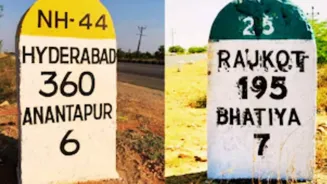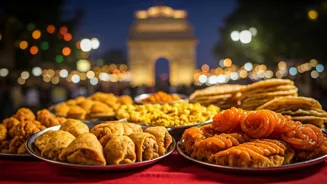Have you ever noticed the milestones along roads in India indicating how many kilometres remain to your destination? These milestones come in different colours, yellow and white, green and white, blue
or black and white, and orange and white. But have you ever wondered why the colours vary?
Each colour has a specific purpose and tells us something about the type of road. So how can one interpret these colours, and how do they help in identifying the road category? Let’s explore in detail.
What Different-Coloured Milestones Mean On Indian Highways?
A milestone painted yellow on the top and white on the bottom signifies a National Highway. These roads connect major cities and states across the country, designed for long-distance travel and fast-moving vehicles. They are maintained by the National Highways Authority of India (NHAI). Examples include NH-44, which runs from Srinagar to Kanyakumari, and NH-19, stretching from Delhi to Kolkata. Yellow is used because it’s highly visible across various terrains and weather conditions.
A milestone with green on the top and white on the bottom indicates a State Highway. These roads connect cities and towns within a particular state and fall under the responsibility of the respective state government. Examples include SH-1 in Telangana and SH-48 in Andhra Pradesh. As State Highways serve regional connectivity, green is used to reflect that local purpose.
Blue Or Black And White Milestones
Should you spot a milestone painted blue or black on the top and white at the bottom, it denotes a city road or district road. These roads typically connect urban centres, towns, or municipalities and are designed to support city traffic.
Orange And White Milestones
An orange and white milestone signifies a village road, usually constructed under rural development schemes such as the Pradhan Mantri Gram Sadak Yojana. Orange here symbolises rural connectivity and development, indicating roads built to connect villages.
Why Road Milestone Colours Matter?
Understanding these colour codes helps you easily identify the jurisdiction and function of the road you’re travelling on. This knowledge is particularly useful when planning a journey or navigating unfamiliar areas.
For instance, if you intend to travel on a National Highway but find yourself on a State Highway instead, recognising the milestone colours can help you course-correct quickly.
So, next time you’re on the road, take a moment to observe the colours of the milestones around you; they might just tell you more than you think.












